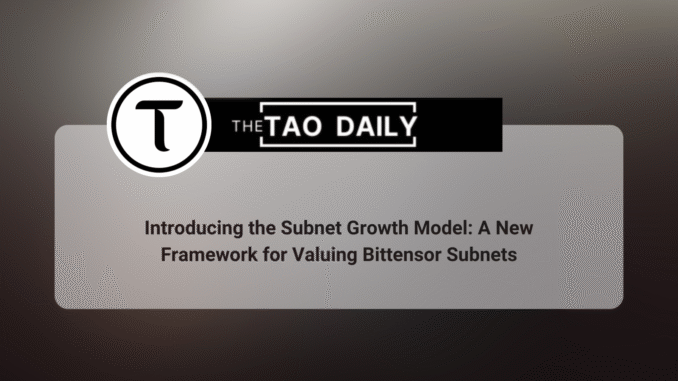
Bittensor stands out as a pioneering protocol that incentivizes the collaborative production of digital intelligence. As the network expands, with over 100 active subnets contributing to everything from language models to protein folding simulations, a critical question has emerged: How do we accurately value these subnets?
Enter the Subnet Growth Model (SGM), a novel valuation methodology proposed by Michael D. White, Managing Partner of Bittensor Fund I.
This framework adapts traditional financial tools to the unique dynamics of decentralized networks, bridging the gap between crypto-native investments and institutional-grade analysis.
In this article, we’ll explore the challenges of subnet valuation, the mechanics of SGM, and its potential impact on the future of decentralized AI investing.
The Need for a Standardized Valuation Framework
Bittensor’s ecosystem is exploding: From just two subnets a year ago to over 100 today, with projections for 200+ by late 2026.
Institutional interest is surging, with 50% subnet growth and a 28% increase in non-zero wallets in Q2 2025 alone.
Yet, challenges persist. Subnet financials are often opaque, with no uniform standards for ownership teams to report revenues, expenses, or projections. This opacity hinders accurate investment analysis, especially for alpha token holders who seek to evaluate long-term viability.
White highlights this in his paper: “The blockchain mechanism that powers the Bittensor network is public and transparent, yet there is no information standard for subnet ownership teams that facilitates complete and accurate investment analysis for prospective alpha token holders.”
SGM aims to solve this twofold: by providing a simple, reliable valuation method and encouraging subnet teams to publish audited financials, fostering confidence and scalability in subnet investing.
The Subnet Growth Model: Core Concepts and Formula
SGM draws inspiration from the Gordon Growth Model (GGM), a staple in traditional finance for valuing stocks with perpetual dividend growth. SGM adapts this to Bittensor subnets, replacing dividends with “Free Cash Flow to Alpha” (FCFA)—the net cash flows available to alpha token holders after expenses.
Read the core concepts and formula in more detail here.
Case Study: BitMindLabs Subnet 34
To demonstrate utility, White applies SGM to BitMindLabs’ Subnet 34 (SN34), focused on deepfake detection. Using provided financials:
- Projected FCFA: Based on TAO inflows, expenses, and growth assumptions.
- ( r ): 20% (conservative for crypto AI).
- ( g ): 5% perpetual.
The model yields a fundamental value suggesting SN34 is undervalued by ~2.5x its market price, implying strong upside if projections hold. This case underscores SGM’s practicality: With audited inputs, investors can run sensitivity analyses, adjusting ( r ) or ( g ) for scenarios like increased competition.
Reception and Future Implications
Launched on September 29, 2025, SGM has garnered positive early feedback. Community members praised it as a “great read” addressing a “huge challenge” for investors, while many bookmarked it for deeper study. White encourages open-source expansion, urging builders to reference and build upon it freely.
Critically, SGM promotes transparency: By incentivizing audited financials, it could mitigate risks like those in less mature subnets (e.g., black-box operations criticized in some analyses).
As Bittensor approaches its halving and subnet expansion, SGM positions subnets as investable assets, potentially unlocking billions in value. For investors, it’s a tool to cut through noise; for builders, a call to professionalize reporting.
In Bittensor, where AI and blockchain converge, SGM isn’t just a model—it’s a step toward maturing decentralized intelligence into a trillion-dollar economy. As White concludes, “Take it. Use it. Expand it.” The future of subnet investing starts here.




Be the first to comment